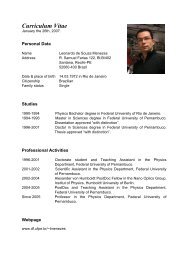Download Abstracts Book - DF-UFPE Pessoal
Download Abstracts Book - DF-UFPE Pessoal
Download Abstracts Book - DF-UFPE Pessoal
You also want an ePaper? Increase the reach of your titles
YUMPU automatically turns print PDFs into web optimized ePapers that Google loves.
ORAL CONTRIBUTIONS<br />
Electric field-assisted consolidation of (Bi,Pb) 2 Sr 2 Ca 2 Cu 3 O 10+y ceramic<br />
samples<br />
E. Govea-Alcaide 1 , I. F. Machado 2 , P. Muné 3 , and R. F. Jardim 4<br />
1<br />
Departamento de Ciencias Básicas, Facultad de Ciencias, Técnicas, Universidad de Granma,<br />
Apdo. 21, P. O. Box. 85100, Bayamo, Cuba, e-mail: egoveaa@udg.co.cu<br />
2 Departamento de Engenharia Mecatrônica e Sistemas Mecânicos, Escola Politêcnica,<br />
Universidade de São<br />
Paulo, 05508-900, São Paulo, SP, Brazil, e-mail: machadoi@usp.br<br />
3 Departamento de Física, Universidad de Oriente, Patricio Lumumba s/n, P.O. Box 90500,<br />
Santiago de Cuba, Cuba, e-mail: mune@cnt.uo.edu.cu<br />
4 Instituto de Física,Universidade de São Paulo, CP 66318, 05315-970, São Paulo, Brazil, e-<br />
mail: rjardim@if.usp.br<br />
Pre-reacted powders of Bi 1.65 Pb 0.35 Sr 2 Ca 2 Cu 3 O 10+y (Bi-2223) were consolidated by<br />
using the spark plasma sintering (SPS) technique. The influence of the consolidation<br />
temperature, TD, on the structural and electrical properties has been investigated and<br />
compared with those of a reference sample synthesized by the traditional solid-state<br />
reaction method and subjected to the same compacting pressure. The uniaxial<br />
compacting pressure used in all samples was 50 MPa. From the X-ray diffraction<br />
patterns, performed in both powder and pellet samples, we have found that the dominant<br />
phase is the Bi-2223 in all samples, but traces of the Bi 2 Sr 2 CaCu 2 O 8+y (Bi-2212) were<br />
identified. Their relative density were ~ 85 % of the theoretical density. The<br />
temperature dependence of the electrical resistivity, ρ(T), indicated that increasing TD<br />
results in samples with low oxygen content because the SPS is performed in vacuum.<br />
Features of the the ρ(T) data, as the occurrence of normal-state semiconductor-like<br />
behavior of ρ(T) and the double resistive superconducting transition, are consistent with<br />
samples comprised of grains with shell-core morphology in which the shell is oxygen<br />
deficient. In addition, the SPS samples also exhibited superconducting critical current<br />
density at 77 K, Jc(77K), between 2 - 10 A/cm2, values much smaller than ~ 22 A/cm2<br />
measured in the reference sample. Re-oxygenation of the SPS samples, post-annealed in<br />
air at different temperatures and times, was found to improve their microstructural and<br />
transport properties. Besides the suppression of the Bragg peaks belonging to the Bi-<br />
2212 phase, the superconducting properties of the post-annealed samples and<br />
particularly Jc(77K) were comparable or better than those corresponding to the<br />
reference sample. Post-annealed samples at 750 oC for 5 min exhibited Jc(77K) ~ 130<br />
A/cm2 even when uniaxially pressed at only 50 MPa.<br />
35






